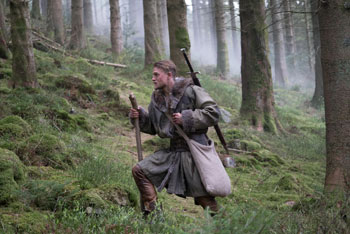Charlie Hunnam King Arthur: Legend of the Sword
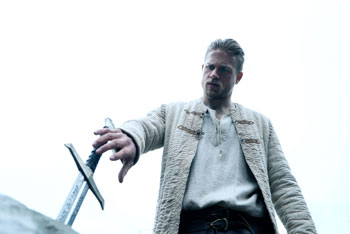
Charlie Hunnam King Arthur: Legend of the Sword
Cast: Annabelle Wallis, Eric Bana, Charlie Hunnam
Director: Guy Ritchie
Genre: Action, Adventure
Rated: M
Running Time: 126 minutes
Synopsis: Acclaimed filmmaker Guy Ritchie brings his dynamic style to the epic fantasy action adventure 'King Arthur: Legend of the Sword." Starring Charlie Hunnam in the title role, the film is an iconoclastic take on the classic Excalibur myth, tracing Arthur's journey from the streets to the throne.
When the child Arthur's father is murdered, Arthur's uncle, Vortigern (Jude Law), seizes the crown. Robbed of his birthright and with no idea who he truly is, Arthur comes up the hard way in the back alleys of the city. But once he pulls the sword from the stone, his life is turned upside down and he is forced to acknowledge his true legacy.
King Arthur: Legend of the Sword
Release Date: May 18th, 2017
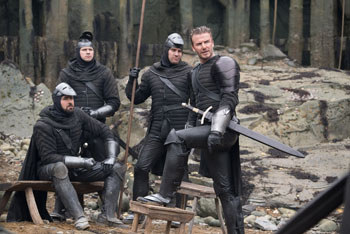 About The Production
About The Production
From nothing comes a king.
Everyone knows the fabled Arthurian legend…or at least thinks they do. But in the hands of director Guy Ritchie, the tale takes on a decidedly gritty, modern edge and Arthur himself, not yet king, is instead a ruffian, a thoroughly reluctant hero compelled to discover his true destiny even as he fights against the very monarchy he is meant to rule.
'I think the best narratives take a man on a journey that transcends his limitations and allows him to evolve from his most basic nature into someone worthy of a bigger life," says Guy Ritchie, who also co-wrote and produced the film. 'In our version of the story, Arthur's life starts small: an urchin in a brothel, running the streets, learning to fight and dodging the law with his mates. Then the actions of others"some with good, some with not-so-good intentions"force him to expand his vision of who he could be."
Nevertheless, it's looking for him, and as soon as Arthur comes into contact with Excalibur, that extraordinary piece of iron firmly embedded in granite, his life will change forever…like it or not.
'This is not your father's King Arthur," producer Akiva Goldsman echoes. 'This isn't a man faced with removing the sword from stone who is anxiously thinking, -Could it be me? Will it be me?' This is a man who is thinking, -What the hell am I doing here? Don't let this be me.' In fact, he has no idea what accomplishing such a feat will even mean for him, but he suspects it won't have a desirable outcome. And he would be right."
While the presence of the famed Camelot was a must, it was producer/co-writer Lionel Wigram who suggested setting the bulk of this big actioner away from the castle, in a more urban environment, and both men were drawn to an ancient version of England's capital: Roman London, which at the time was called Londinium.
Lionel Wigram states, 'There have been many separate and differing versions of the King Arthur story, in which he has been everything from a Celtic warrior to a Roman centurion.
The myth has endured and has been adapted to fit the requirements of each different time period in which it has been told. Given this rich tradition of interpretation, we felt that as long as we retained its essential thematic elements, we had license to come up with our own iteration of the story, to have some fun with the details in a way we hope will speak to today's audiences."
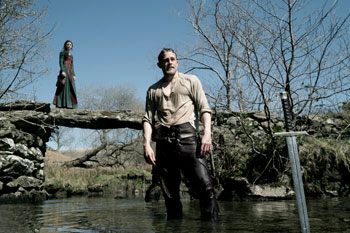 Of course, no King Arthur story would be complete without a bit of magic. Instead of dragons, however, the filmmakers wanted to create a new and unique mythical world, with 'elephants longer than a football field and snakes as big as subway trains!" divulges cowriter/producer Joby Harold.
Of course, no King Arthur story would be complete without a bit of magic. Instead of dragons, however, the filmmakers wanted to create a new and unique mythical world, with 'elephants longer than a football field and snakes as big as subway trains!" divulges cowriter/producer Joby Harold.
Feeling free to skirt around historical accuracy"the story is based in legend, after all" Harold envisioned a distinctive way to offset the grounded elements. 'This is not your typical fantasy film. Fantasy is usually more lyrical, while this is much more textured, much coarser, and for me that is what makes it interesting as a fantasy landscape. We explore what it would be like to grow up one way only to discover your heritage is something else entirely. We give audiences the time to really get under Arthur's skin, but we counter that sense of reality with Lionel Wigram says, 'Joby went for the jugular, sprinkling in magic, spectacle and immense creatures and all that kind of fun, in order to give audiences an exciting and unexpected visual adventure to go on along with Arthur."
Adding to the unconventional is the fact that the era's most noted magician, Merlin, appears only briefly. Producer Tory Tunnell explains how the character influences the story despite his near absence: 'Merlin has always brought the magic into Arthurian legend, but we wanted to paint a broader picture of the concept of magic in a way we haven't seen before.
Imagine a backstory to Merlin's larger world, how the mages might have interacted within the mortal sphere, including the menacing side of their efforts. This is, after all, the medieval period through the Guy Ritchie lens, so you can expect to be surprised, and that's always exciting."
One of the story's enthusiasts for the darker arts is Vortigern, Arthur's uncle and the sitting king bent on keeping his place on the throne, no matter the cost. To bring the right amount of gravitas to the ultimate villain, Ritchie turned to his 'Sherlock Holmes" star Jude Law, who played the affable Dr. Watson.
'We had a great collaboration on both -Sherlock' films," Jude Law recalls, 'so when Gyy Ritchie approached me with a view to playing Vortigern, I was curious. He described the story as a way of looking at British folklore as opposed to history, and this character as a man who is battling his circumstances, his own ego, a devil within. I found that really intriguing and immediately looked forward to the process and to working with Guy Ritchie again."
Producer Steve Clark-Hall, who has worked with Guy Ritchie on the director's last five films, says that one of the things he finds most interesting is the way Guy Ritchie approaches character. 'Guy Ritchie is very consistent in making sure the characters in his movies have a real appeal, whether they are good guys or villains. It was just as important to him that audiences be able to relate to Vortigern as to Arthur, because at the heart of all the epic action and giant monsters, it's really the underlying dynamic between these two and the lengths to which either is willing to go to defeat the other that will determine their fate, and everyone else's. That's what makes the story so compelling."
Ironically, Vortigern wouldn't even be in this predicament if his ego and unquenchable ambition hadn't driven him to seek out the 'born king." If he'd simply left well enough alone, would his nephew ever have learned who he really is? As Arthur himself readily attests, he never had any power, or any desire for it. So when he tells his uncle, 'I am here, now, because of you"you created me," Arthur can't possibly know how the current king will act, nor can Vortigern trust Arthur to let things stand as they are, despite his claims.
'This is an Arthur who doesn't aspire to greatness"fate throws it at him," Guy Ritchie says, 'and he fights it, and pretty much everyone around him, every step of the way."
And fight he does, in visceral action sequences that include spectacular displays of bows and arrows, battles of hack-and-slash swordplay, mad dashes through the grimy back alleys of the city, and a mix of martial arts and bare-knuckle fighting. It was all captured in stunning UK locations throughout Wales and Scotland and on the cavernous Warner Bros. Leavesden soundstages, and set to a pulsating score.
It all adds up to Guy Ritchie's 'King Arthur: Legend of the Sword," in which Excalibur reveals itself, and a man's true calling along with it.
Behold, the man who pulled sword from stone!
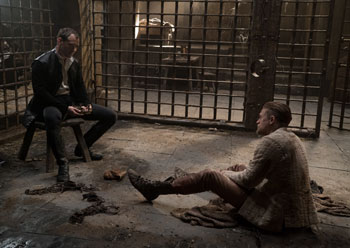 Take a shrewd street thug with an irreverence for authority, yank him out of his barebones existence and surround him with otherworldly magic and colossal creatures, then advise him that he is, in reality, a king who must fight for his life, and you have Arthur"né Pendragon"a man meant to be a hero but struggling with his very identity, even as he attempts to stay alive.
Take a shrewd street thug with an irreverence for authority, yank him out of his barebones existence and surround him with otherworldly magic and colossal creatures, then advise him that he is, in reality, a king who must fight for his life, and you have Arthur"né Pendragon"a man meant to be a hero but struggling with his very identity, even as he attempts to stay alive. 'King Arthur: Legend of the Sword" introduces an Arthur who was raised in a brothel on what would definitely be considered the wrong side of town. Now he runs the back alleys of the city with his gang of friends, completely unaware of his true provenance. But as bad luck would have it, Arthur is shipped off to Camelot where he, like every man of a certain age, is put to a test: to pull a sword from a stone, a futile effort for most as only one man among them can complete the task. Finding him is the true test; passing that test is a death sentence. And in his rush to take his turn so he can return to his present life, Arthur quickly comes face to face with the one thing that can reveal to him the truth of his past and the possibilities for his future. If only he wanted to know.
'As far as he knows, Arthur was always poor; he's had to take anything he wanted, he's never been given anything," Charlie Hunnam offers. 'When he grasps hold of Excalibur, it overpowers him in every way, and he rejects it and anything that comes with it. He doesn't even take it seriously. He doesn't want the responsibility."
Not so for Charlie Hunnam, says Guy Ritchie. 'I'll tell you what's great about Charlie"everything. He worked very hard and he never moaned for a second, even though we asked him to do some pretty tough stuff. He's a decent, kind, thoughtful and talented human being. I liked him at the beginning of production, I liked him more every day and I adored him by the end."
The admiration went both ways. 'This was the best experience on a film I've had so far, and that's because of Guy Ritchie," the actor says. 'I had a blast, and it was a great learning experience and a real period of growth for me. Guy Ritchie makes decisions in real time, immediately coming up with a solution if something's not working. The environment comes alive to him and he works with the actors in a very instinctual way. If I came up blank on any given day, he always had ten ideas."
Not unlike Arthur, himself. A natural leader"much more so than he knew, as he'll learn over the course of the film"the character is at once charmer and snake, protector and bully, and by necessity, thanks to his somewhat hand-to-mouth existence, a quick thinker.
'Arthur had to be immediately likeable for the unorthodox story to resonate," Lionel Wigram says, 'and Charlie Hunnam's so down to earth and such a good guy, and has such charisma, he jumped out at us right away. He really exuded the cockiness and confidence appropriate for the character, with the right combination of street lad bravado and vulnerability, and he came to set every day with an unflagging energy and a willingness to have a go at anything, which was just great."
Just as Excalibur plays a part in leading Arthur to his fate, Charlie Hunnam reveals, 'It was instrumental for me in crystalizing the dream I had of becoming an actor. I watched all the films about the Arthurian legend over and over again when I was about six or seven. I actually had an Excalibur that I carved out of wood so I could play Arthur. So, to then be on a set in a version of Londinium playing King Arthur for real was pretty wild."
Having spent some ten years in the United States, the Newcastle native found acting without an American accent, and then determining the appropriate manner of speaking for the character, to be an unexpected, yet invigorating, challenge. 'We talked a lot about what Arthur's accent should be and decided that a received pronunciation, be it contemporary or historical, would be wrong. We then looked at having him speak like a cockney geezer and thankfully abandoned that, too," he laughs.
'Since Arthur comes from royal blood and would have heard that elocution in early childhood, but then is thrust out on his own and exposed to a lot of street talk in the city, we put his accent somewhere in the middle," Charlie Hunnam reflects, 'somewhere between Vortigern's posh-sounding talk and Arthur's own cockney crew."
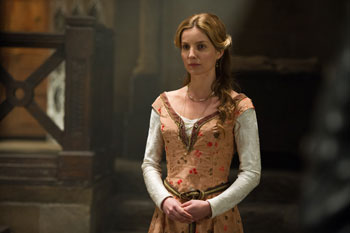 As your power increases, so, too, do the forces that will oppose you.
As your power increases, so, too, do the forces that will oppose you.When Vortigern discovers the born king really did survive, one of his closest advisors warns him: 'You wanted a prophecy? This is your prophecy!" In other words? Careful what you wish for; search for the true heir to the throne and you just might find him.
Played with equal measures of dignity and desperation by Jude Law, Vortigern is a pretender to the throne who's had to barter for his power all these years. He can almost taste his victory now it's so close, now that he has Arthur under his roof at last. Jude Law reveals, 'Vortigern rules through fear. He's purging the country of mages and the old ways in order to harness the control solely for himself. But the way he came to rule preys on his conscience, on his soul. It's very dark and very twisted. And over time, he's almost developed an addiction to the control, to his supremacy, so he's a man wrestling with his inner devil, that devil being his own ego. It doesn't matter that Arthur has no awareness of his own status; he's a perceived threat to Vortigern's delicate hold on the power he craves."
Guy Ritchie notes, 'We wanted Vortigern to be more than just a bad guy, and Jude Law isn't a predictable choice for the villain. I had total faith in him and he gave us a really layered bad guy who you love to watch."
Harold notes, 'To see Jude Law peeling Vortigern apart very slowly is a great thing. There's a constant tension between what the character wants and what he needs and he is living in perpetual guilt, but he can't stop himself. He has sacrificed what he loves and will do it repeatedly because what he wants is more important."
Jude Law adds, 'Vortigern believes he is the righteous king, and he thinks Arthur, this peasant whippersnapper, can't possibly bring anything to the throne. Within the reimagining of this mythology, the writers were clearly curious about the layers to this character, and for an actor, those were good discussions to have. That, and stomping around in armor with hundreds of soldiers and dogs and men on black horses, made this film truly fun to be a part of."
Jude Law worked with Charlie Hunnam several years prior, on the film 'Cold Mountain." Law recalls, 'In that film, Charlie Hunnam played the villain and I was the good guy! He's a great actor, very collaborative, and has a solid work ethic."
During filming on 'King Arthur," Charlie Hunnam became an even bigger fan of his co-star. 'I think Jude Law is terrific, and I think his performance in this film is one of his best to date. He did sensational work."
The warning to Vortigern aside, it will take much more than a prophecy to see Arthur take his rightful place upon the throne. While a Resistance has been forming to support his ascension, it will be up to one exceptional young woman, The Mage, to help the born king see his way forward by forcing him to look back.
A sorcerer who practices an ancient craft, she is one of the few survivors of her kind, the majority having been exterminated or driven into hiding by Vortigern's thirst for power and his unholy alliance with the malevolent wizard Mordred. Especially attuned to nature, mages have special abilities that allow them to control other living creatures, including horses, birds of prey and snakes.
French actress Astrid Bergès-Frisbey, who plays The Mage, says, 'The Mage finds Arthur really immature and self-centered, but she is constant and focused on the work she has to do in order for him to evolve into the king he needs to be. The evolution is his, he can't reach it alone, and she is the key to his journey of accepting his destiny."
Astrid Bergès-Frisbey did a good amount of research for the role, studying the legend and leaning on dialect coach Julia Wilson-Dickson. 'She knew Gaelic, which was the base for The Mage's incantations, and she helped me develop the unique way she speaks. I owe Julia a lot," she says.
'Astrid Berges-Frisbey infuses The Mage with a wonderful ethereal quality that truly evokes the mystical nature of the character, while also giving her an earthiness that speaks to her connection with the animals," Tunnell observes.
Because The Mage travels primarily by horse, the actress spent hours riding, under the guidance of the production's horse master, Daniel Naprous, and his sister, Camilla Naprous. 'Because I was familiar with horseback riding, Camilla let me ride her personal horse for the movie. This horse was unbelievable, but it required me to train more. Since my character has a special relationship with animals, I enjoyed riding to build a closer connection to them."
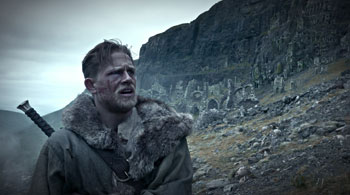 One of The Mage's most critical tasks is to lead Arthur to an understanding of the intense images he sees in his dreams and whenever he holds Excalibur. Among them, he sees a very young boy in the arms of his father. But without context, how is he to know he is that young boy and that the father is"was"his own?
One of The Mage's most critical tasks is to lead Arthur to an understanding of the intense images he sees in his dreams and whenever he holds Excalibur. Among them, he sees a very young boy in the arms of his father. But without context, how is he to know he is that young boy and that the father is"was"his own? The pivotal role of Arthur's father, the brave and just King Uther Pendragon, was filled by Eric Bana. 'I've known Guy Ritchie for a long time and was intrigued to see what his take on this world of fantasy and myth would be," the actor says. 'He's terrific with action and my character gets straight into it. When we first see him, it's almost as if we've arrived mid-beat into something that's going on, and he's got no time to waste; he's got to get right into battle to defend his people."
Despite the impressive throne crafted for the king, Eric Bana says, 'I saw it in the background when we did a big scene in the throne room on my first day, but I didn't even get to sit in it!" Uther does, however, wield the sword Excalibur. 'That was great, and lucky for me I've done sword fighting in films before, so knowing the basics, along with the additional training, gave me a leg up."
One of Uther's most trusted advisors, Bedivere has been in hiding since his king's death some 25 years ago. Djimon Hounsou plays the leader of the Resistance who seeks a return to better times. 'Camaraderie, solidarity, a sense of responsibility"these are big themes within the film," Hounsou relates. 'My character, Bedivere, can see the big picture. He has been patiently waiting for the right time for rebellion, trusting that the born king will present himself before it's too late."
Having served Arthur's father faithfully, Bedivere also serves as something of a adviser to Arthur in the film. Charlie Hunnam and Hounsou also developed a close relationship. 'I adore Djimon as an actor. He has a real presence about him and we bonded as soon as we were introduced. He is Arthur's mentor in the film but he is also a wonderful mentor in life." 'I love Djimon, he's just a spectacular chap," Ritchie raves. 'I've known him a while but I was glad for a chance to work with him finally."
No stranger to medieval times, 'Game of Thrones" veteran Aidan Gillen plays 'GooseFat" Bill, a long-distance marksman with a bow and arrow that makes him the ideal assassin, and another valuable member of the Resistance. Like Bedivere, he has been cast into a half-life while waiting to overthrow Vortigern's rule.
'Bill's one of the gang but doesn't come from the streets. He's a gentleman but he's living as a fugitive, so he certainly knows how to handle himself," says Gillen. 'Guy is great at portraying the camaraderie between men, and this film has a lot of that, as well as humor, adventure, mysticism and magic."
Guy Ritchie states, 'I always think men understand that frequency of other men, no matter where they come from. Culture, class, creed or color is irrelevant; they get one another's jokes and they just crack on. I suppose that's what we tried to do for this film, to come up with an amalgam of chaps like we all grew up with and see how they would fuse when sort of forced together. They have to get on because they have this common purpose."
Gillen worked with costar Charlie Hunnam on one of the latter's early acting gigs. 'He was just 17 or 18 then, and it was great working with him again and seeing him now as a grown-up. Charlie's a great Arthur because he's got that youthful cheekiness along with a serious physical presence."
Other members of the Resistance include Freddie Fox as Rubio and Craig McGinlay as Percival. Kingsley Ben-Adir is Wet Stick and Neil Maskell is Back Lack, Arthur's right-hand men and fellow racketeers in Londinium, along with Bleu Landau as Back Lack's son, Blue, Tom Wu as Arthur's fight master, George, and Michael McElhatton as Jack's Eye, the local Blackleg sergeant with whom Arthur has a 'friendly" understanding.
At Camelot, Annabelle Wallis is maid Maggie, with Peter Ferdinando as Vortigern's advisor, the Earl of Mercia. Mikael Persbrandt plays the leader of the Vikings, Greybeard, who comes into conflict with Arthur. And a scar-faced, broken-nosed David Beckham appears in a cameo as one of Vortigern's Blacklegs standing guard over the proceedings around Excalibur.
Why does the sword reveal itself now?
As noted in the first few frames of the film, for centuries man and mage lived side by side in peace, until the rise of the mage sorcerer Mordred. Turning his dark ambition against man, he marches on the last remaining stronghold: Camelot.
With the castle and its surrounds under siege, the heir to the throne, still a toddler, floats quietly toward the city, tucked away in a tiny boat like Moses, safe from tyranny…for now. For Guy Ritchie, it was the boy's destination that held the strongest attraction for him as a landscape for 'King Arthur: Legend of the Sword." The origin story called for an unusual setting, one far from anything royal.
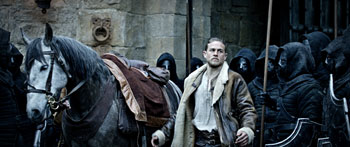 'I was always fascinated by the idea of Roman London and the lack of physical evidence of it that remains now," Ritchie relates.
'I was always fascinated by the idea of Roman London and the lack of physical evidence of it that remains now," Ritchie relates. 'Though it's arguably been the world's capital for two millennia, apart from maybe Constantinople and Rome, London is a victim of its own success and has obliterated much of its history. Very few people know that London was once Londinium, a thriving Roman city, most of which is 15 or 20 feet underground by now thanks to the sheer quantity of buildings that have been built on top of it. So we created our own version of it."
The film was lensed by Guy Ritchie's director of photography from 'The Man from U.N.C.L.E.," John Mathieson, and cut by James Herbert, marking the director's sixth project with the editor. 'King Arthur" marks production designer Gemma Jackson's first outing with Ritchie, and she began with extensive research and by drawing a number of concept sketches. She gradually created a world inspired by history but still all its own, and one that would satisfy the demands of the story: a world where the ordinary sat comfortably alongside the fantastical.
'You have to build a reality, the film's reality, which has ground rules that the architecture and design abide by," she says. 'It has to be a consistent world that the audience will believe in. And also a world that includes 300-foot elephants and giant snakes."
Built at Warner Bros. Studios Leavesden, three key sets, which ultimately served nine different purposes, provided Jackson with the greatest creative challenges and the most professional satisfaction: Londinium, Camelot and the Syrens' cave. 'Guy Ritchie and Lionel wanted a kind of post-apocalyptic Roman London," says Jackson. 'It's perhaps the 8th century, and the Romans have gone and the Saxons are living there. The whole place is falling apart."
'The Londinium set is the biggest set I've ever seen, with a beautiful harbor behind it and spectacular interiors that really do justice to the ancient world," Steven Clark-Hall says of the build.
Ritchie agrees. 'Gemma's one of those people I'm humbled by. She has extraordinary ideas and executes them flawlessly, and whenever I change my mind at the last minute, she smiles with great enthusiasm and finds the perfect way through."
Contrasting with the ramshackle urban streets of Londinium is the imposing magnificence of Camelot, one of the chief design concerns for Jackson because of its mythological status. 'It is so many things to so many people, so how to manifest the myth?" she posits. 'The idea was that the whole palace is chipped out of a rock. We built it onto an existing hillside at Leavesden, which immediately gave it a sense of scale and geography. I could only build to a certain height, but the castle was drawn up in readiness for the VFX department to complete. There was a huge amount of scripted action entering and leaving the castle, so we built a 200-foot-long bridge, which meant that horses could genuinely get a good speed up."
Jackson decided that the throne room in Camelot would be steeped in history, and took inspiration from the ancient palace of Sigiriya in Sri Lanka, the ruins of which stand atop a granite peak. Carved into the rock are a series of staircases and galleries emerging from a huge lion made of bricks and plaster, which give access to the site. Adorning the walls of the palace is a series of beautiful frescos.
To evoke that imagery, Jackson designed a huge stone interior space with towering columns. The set was ornately decorated, including two painted murals with vast gold leaf skies and windows made of intricate stone latticework. 'The colors gave the light an ethereal glow as it shines through the lattice," Jackson describes. 'The latticework was computer generated, laser cut and then overlaid with polystyrene in the sculpture shop to give it the depth, and finally plastered so it would look like stone. The elaborate throne sat within a deep blue cupola."
The whole set had a sense of Byzantium, one of Jackson's much-loved sources of stimulation. Another key set at Leavesden was the Syrens' cave, a mysterious and terrifying rock world existing deep beneath the foundations of Camelot castle, where the magical forces are allpowerful. A chamber carved out of rock and accessible by a staircase leading down to a natural pool, it was illuminated by an opening far above, which was the mouth of the castle well. Lurking deep in the winding network of underground rivers are the Syrens: one creature that morphs into three parts, two parts beautiful, one horrendous. They are the evil spirits who promise Vortigern his power"but only after his sacrifice.
'The Syrens live off the blood of love," Ritchie clarifies. 'They will give a person power in the material world proportionate to how much love that person is willing to sacrifice to them." The 60-foot-deep cave that was built for the Syrens was then transformed into the remote place where Bedivere lives until he and his band of brothers can rescue Arthur and join his battle for power. 'We built a shimmering underground lake," Jackson says, 'and when we completed filming the scene, we emptied the tank. Using the rock set above, we then turned the space into a high-roofed grotto situated deep within the cliffs, where Bedivere and his gang hide out. Within the space, we built a complex wooden structure from trees and branches, to give some division to where everyone co-existed."
For the lands surrounding Camelot, location manager Amanda Stevens says, 'Gemma and I felt that the landscape should be one with dramatic, barren vistas that wouldn't have changed for centuries, so the challenge was finding that in today's countryside, which has had centuries of partitioning and farming."
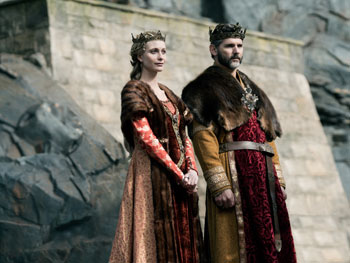 Stevens spent several weeks travelling the country until she honed in on an area in Wales called Snowdonia, which offered several different locations within a ten-mile radius of base camp. The site is designated of special scientific interest (SSI) by the UK's conservation charity, The National Trust. It took Stevens and her team six months to gain approval from the government's regional environment adviser, National Resources Wales, to build the story's required burial ground in Gwern Gof Isaf.
Stevens spent several weeks travelling the country until she honed in on an area in Wales called Snowdonia, which offered several different locations within a ten-mile radius of base camp. The site is designated of special scientific interest (SSI) by the UK's conservation charity, The National Trust. It took Stevens and her team six months to gain approval from the government's regional environment adviser, National Resources Wales, to build the story's required burial ground in Gwern Gof Isaf. In stark contrast to Snowdonia, the Forest of Dean, which borders Wales and England, provided a divine backdrop for some of the Darklands scenes, where The Mage sends Arthur for a trial-by-fire discovery of his true heritage, as well as a spot for the exterior of Bedivere's dwelling, ironically known locally as King Arthur's Cave. A vibrant mix of grassy woodland, rocks, hills and trees, the region is also home to the River Wye. The river was used for the end of a sequence in which Arthur and friends jump off the top of a mountain edge into the Vivian Quarry (accomplished in Snowdonia), emerging in the Wye. Additional Darklands scenes were captured on location in Scotland and the adjacent Isle of Skye.
'The level of detail and love and attention and skill that went into these sets was breathtaking," says Charlie Hunnam. 'For me, stepping into these environments created a sense of real responsibility to up my game and make sure I did the best possible work, in order to do justice to the work that went into creating them."
Jude Law observes, 'The world they created at Leavesden and beyond was absolutely incredible, familiar but also completely new. It's rare to be on a film set with that kind of a build; the scale had to be embraced. It was exhilarating to be a part of."
An equal measure of devotion went into designing the costumes for the cast and its many extras. To dress Charlie Hunnam, Jude Law and the rest of the company, costume designer Annie Symons says she began with historical reference, paintings and carvings, then 'funked it up a bit, made it sexier. We didn't want the old sackcloth look. I wanted to design clothing that wouldn't be too alien for younger audiences, but rather almost familiar. You have to believe in the people you're watching, and what they're wearing is a part of that. And, as Guy Ritchie said, -Make the characters look cool, give them a bit of swagger, and make the goodies look as interesting as the baddies.' Good notes!"
To that end, she went to Camden and Spitalfields, two top street markets in London, to photograph young people in their tribal youth looks. 'I printed the photos out in black and white so that the colors weren't distracting, and started to analyse the shapes. Then I referred back to medieval costumes and tried to synthesize the two."
She was also guided by the imagery of the setting. 'The Londinium of the film is multiracial, multi-cultural, multi-everything, pretty much like London today is all washed in grey, black and smog. I wanted to create a bit of a world that wasn't completely medieval," she explains. 'We had to find a visual language that fitted this story. So I also looked at Japanese, Chinese, Turkish and African clothes, especially their patterns, and abstracted a geometric city camouflage.
'I even went to the gym to see how the people training moved," she continues. 'Arthur had to be able to move easily because he's all about action and I wanted to maintain simplicity in his appearance, a medieval equivalent of jeans and a t-shirt. Those things came together quite well. He started off a boxer and there's still a vestige of the boxer in his boots, which are a mix between a boxing boot and a gladiatorial sandal."
Symons color charted her characters as well. For Arthur, she opted for a neutral palette with white shirts. 'Working class boys in London always wear nice shirts, always clean, always ironed," she observes. His costumes featured natural linens and leather with a sheepskin coat.
For Arthur's gilet"the lightweight jacket he wears throughout the film"Symons had her cutter make a padded, layered linen jerkin, into which she then punched holes and hand-stitched detail, and for which she fashioned a brass closure to give it a bit of flash. As the story progresses, Arthur dons a khaki camouflage campaign jacket, which he sports throughout the Darklands. Arthur's natural shades counter his father Uther's court attire, which displays in true Camelot style the crown's extraordinary wealth through the use of rich golds, colors inspired by stained glass, and 'precious" stones, such as emeralds and rubies. For Uther's brother and the man desperate to keep his crown, Vortigern, Symons chose a cool palette of greens, blues and silvers teamed with black leather. 'Vortigern wears black tooled leather collarless tunics with black trousers and a stunning white fur cloak with embossed knee-high leather boots. The pewter-colored metalwork in his crown, buckles and armor is more engineered and more technologically advanced than the ancient craftsmanship of Camelot and Londinium. He also has an imposing full-length midnight blue velvet coat with a Nehru collar."
The designs for Vortigern's army, the Blacklegs, were influenced by cockroaches, 'the hard, shiny, indestructible beetles swarming the streets, and their identities were hidden by sinister leather masks," Symons details.
The Mage's look is simple and elegant with dark hues to reflect her mysterious beauty. Symons designed a series of dresses in deep blues, greens and claret in clean A-line shapes with rough hems and a plaited suede belt, all worn under a blue hooded coat. The Mage's action wardrobe was based on a specially designed forest camouflage and incorporated embroidery of forest flowers and insects.
 Symons and her team trawled fabric suppliers and costume houses all over Europe, and had fabric flown in from New York, Italy, France and Turkey. The woven wool they used was sourced specifically in Scotland and Yorkshire.
Symons and her team trawled fabric suppliers and costume houses all over Europe, and had fabric flown in from New York, Italy, France and Turkey. The woven wool they used was sourced specifically in Scotland and Yorkshire. The costume department created all the embroidery, leatherwork, armor and jewelry" everything but the shoes, which were made by an independent English cobbler and fitted with special water-absorbing soles for the action sequences.
'The costume department was like an ancient village of artisan huts, full of specialists in leather, metal, millinery, dying, printing, embroidery, blacksmithing, sewing…" Symons recalls.
'Almost everything was completely original, which is extraordinary, really. In (wo)man hours, it took two weeks to get a prototype jacket together, whether it was Arthur's sleeved gilet or Maid Maggie's hand-tooled, chalk leather intaglio bolero."
It took considerably longer to handcraft the crowns, Highland cattle headdresses of the mage army, and the uber-feminine, floaty frocks for the females of the castle. 'Hours and hours and miles and miles of plaited ribbons," Symons recounts fondly.
It was a mage"Merlin"who gave you the great sword. As he did Jackson and Symons, Ritchie provided a similar brief regarding historical authenticity to supervising armourer Tim Wildgoose, encouraging him to take inspiration from contemporary times and create something new and unique.
'There's a distinct look to weapons from that era historically, but because this is mythology we could give it a slight twist. We tried to stick to methodologies that were possible at the time; for example, the shields aren't historically accurate in terms of shape but they could have constructed them back then. We bent the reality slightly and came up with something that's a bit more interesting than what was the standard of the time.
'It's obviously a lot easier to make a sword in modern times than it was to make back then, because back then a sword would have been made in a forge," he continues. 'Steel would have been heated up until it was red hot and it would then be hammered out. It would take days and days to make a single sword blade by folding, hammering, shaping, grinding. Now we make a 3D model, put it into a computer numerical control (CNC) machine, and it will produce a blade in a couple of hours!"
The design of Excalibur was not so easy a task; it had to stand out from all the others. Wanting the blade to appear subtle and practical in its beauty, rather than elaborate and jewelencrusted, Ritchie was also keen that the sword have a Damascus blade, which uses the method of layering carbonized steel and normal steel, making it both very hard and sharp and also very flexible. The final piece Wildgoose created had etched into the blade the phrase 'Take me up, Cast me away" in runic script.
For Arthur, Excalibur is not merely a fine piece of weaponry. Charlie Hunnam details, 'One of the beautiful ideas relating to the sword is that it creates a circuit when you hold it with both hands. Energy passes through Arthur's body, but the emotional trauma of his past blocks that energy, so Arthur has to use the sword to go through a catharsis, to flush the emotional trauma out of his system so that he can achieve the balance necessary to control the sword. It makes Excalibur very exciting as an instrument but also contributes to the arc of the character's narrative."
The armory team also made an open-front scabbard to show off the blade whenever Charlie Hunnam wore it. 'The making of Excalibur was really a team effort," says Wildgoose. 'There were eight or nine people who contributed to different parts of it. One artisan made the blade. Another one etched the blade. Someone else made the hilt. Someone else made the handle. Another worker made the scabbard. A leather worker made the leather finishes. And someone else made the crystal to go in the end. We got the final sword done about four days before we started shooting, and it was incredibly satisfying to know so many hands went into crafting it."
Forty copies of the sword were made, ten out of metal and 30 rubber stunt versions. In total, the team made upwards of 2,000 weapons, including swords, shields, spears and ballistas.
The ballistas were, inevitably, not of the garden variety. 'The ballistas we built were 14-feet high and 14-feet wide, weighing in at about a ton each, and we built four of them," Wildgoose cites. 'They were constructed of wood and steel, more or less how they would have been built back then. They were fully operational."
The Blacklegs"Vortigern's guards who protect the castle and patrol the streets of Londinium"carried batons inspired by modern riot police. 'The Blacklegs carry a club or baton to keep the civilian population in line, as a sword is a bit more final. A baton is more threatening in a way, because they're more likely to use it," Wildgoose says.
To properly wield Excalibur and all the other weapons used in the film's many impressive battles of varying size and style, the cast members were tutored by stunt coordinator Eunice Huthart and fight coordinator Mike Lambert.
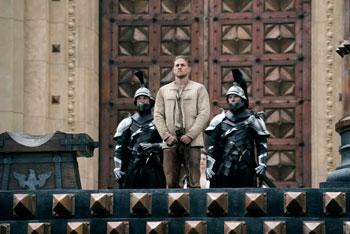 Of course, the cast makes a big difference to any stunt coordinator's job, and Huthart was grateful for the actors she was collaborating with on this film. 'For a stunt coordinator, Charlie Hunnam is probably the dream guy," she says. 'There's nothing he can't do, and he is so game and so creative. Same with Jude Law. When I read the script I always like to sort of get in with the characters, because whatever action I deliver, I want it to be character-related, and Jude law embodied Vortigern exactly as I interpreted him."
Of course, the cast makes a big difference to any stunt coordinator's job, and Huthart was grateful for the actors she was collaborating with on this film. 'For a stunt coordinator, Charlie Hunnam is probably the dream guy," she says. 'There's nothing he can't do, and he is so game and so creative. Same with Jude Law. When I read the script I always like to sort of get in with the characters, because whatever action I deliver, I want it to be character-related, and Jude law embodied Vortigern exactly as I interpreted him." 'I'd done a small amount of horse riding in the past," says Hunnam, 'but no sword fighting at all. It's great to spend the day learning new skills and new talents as part of one's job, so with all we had to do for -Arthur,' it was pretty exciting."
In terms of Arthur's physicality, Charlie Hunnam, who put on 20 lbs. of muscle for the role, continues, 'Guy Ritchie and I talked a lot about him as a feral street kid, a starving wolf-type, with the idea that he had grown up fighting and that he had a hunger to him, but also an underlying nobility deep down. I was really intent on finding a physical way to show that. I'd done martial arts training and fight training in the past, and it does give you a certain confidence, so I spent a lot of time in the gym, not only for the physical effect but for the emotional effect that comes with throwing a thousand punches a day."
While the street fights represent the story's down-and-dirty realism, the movie grabs audiences right from the get-go with an awe-inspiring battle that pits King Uther and those loyal to him against the mages who are ruled by the infamous Mordred. This war occurs after a longheld peace between the two kingdoms has broken down.
'The Mage battle is on an enormous scale," notes visual effect supervisor Nick Davis. 'It involves 300-foot elephants that don't exist attacking a castle that doesn't exist, so there are a lot of elements to that. It was a big challenge to create the fantasy component while keeping it within the photorealistic, gritty world that these characters inhabit."
In addition to creating elements that were never there, Davis's team was required to enhance those that were, such as extending the city of Londinium beyond the sets designed by Jackson.
But one of the most crucial aspects of Davis's job on this film was to help create the effects surrounding that all-important sword. 'The relationship between Arthur and Excalibur was key," he affirms. 'The sword had to aid in the narrative as well as have a visual impact, and the challenge was balancing those two elements. Is the sword in charge, or is Arthur? As he develops control over it, that relationship changes, therefore the effects should reflect that. So, in every sequence the effects of the sword actually change as Arthur gets more in tune with Excalibur, and with himself."
The Born King will come. It is inevitable.
As in every Guy Ritchie movie, the score and soundtrack play a critical role, and the filmmaker turned again to composer Daniel Pemberton, his musical counterpart on 'The Man from U.N.C.L.E." While there's an edge to 'King Arthur: Legend of the Sword" that's definitely modern, the music had to be decidedly different.
'What matters to Guy and to me is to make a score that sounds like nothing else; that was the mission. We wanted to rewrite the rulebook for a film of this scale. Like pulling a sword out of a stone, just a bit harder," Pemberton smiles.
'For -King Arthur,' we wanted the music to feel visceral," he continues. 'There is so much rich imagery in the world of the movie: the dirt, the grime, the metal, the leather, the wood, the stones. I wanted to bring as much of this into the score as I could, and to capture everything from the struggle and fight of an orphan raised on the streets to the nobility of a leader who could change history. And with Guy, the usual rules don't apply"in fact, no rules apply!"
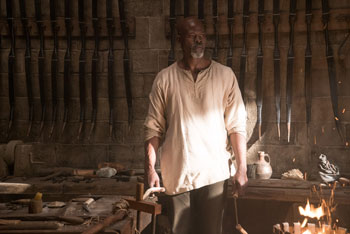 To suit the period, Pemberton researched the world of early music enthusiasts who collect, make and play ancient instruments. 'If it sounded like it could have existed 500 years ago, we tried to use it," explained the composer. Among the unusual implements he discovered was the 'wonderfully horrible Tromba Marina, a huge stringed beast from the 15th century"; an 'impossible to tune Hurdy-Gurdy"; a Swedish Nyckelharpa; a Hardanger fiddle; a Vielle; and a device that earned the nickname throughout the production as 'the toilet horn"; as well as rocks and a pair of chopsticks.
To suit the period, Pemberton researched the world of early music enthusiasts who collect, make and play ancient instruments. 'If it sounded like it could have existed 500 years ago, we tried to use it," explained the composer. Among the unusual implements he discovered was the 'wonderfully horrible Tromba Marina, a huge stringed beast from the 15th century"; an 'impossible to tune Hurdy-Gurdy"; a Swedish Nyckelharpa; a Hardanger fiddle; a Vielle; and a device that earned the nickname throughout the production as 'the toilet horn"; as well as rocks and a pair of chopsticks. Pemberton and his equally game musicians were joined by vocalist Sam Lee as well as a vast hybrid of instrumentation both old and new. And the composer even used his own body" from hand and face slaps to distorted screaming and breathing"to try to create an inventively unique score unlike anything audiences have heard before.
'For me and I hope everyone I work with in the cast and crew, making movies is like watching movies: it boils down to wanting to have fun," Ritchie surmises. 'There are certain genres we loved as kids that we filmmakers feel can be done for a modern audience in a way that wasn't possible back when we watched them. I hope that pulling that sword from the stone and going on a real hero's journey with this -King Arthur' can give today's moviegoers the same pleasure we experienced in the theater when we were lads, but in a fresh and exciting new way."
King Arthur: Legend of the Sword
Release Date: May 18th, 2017
MORE
- Mission: Impossible Fallout
- Glenn Close The Wife
- Allison Chhorn Stanley's Mouth Interview
- Benicio Del Toro Sicario: Day of the Soldado
- Dame Judi Dench Tea With The Dames
- Sandra Bullock Ocean's 8
- Chris Pratt Jurassic World: Fallen Kingdom
- Claudia Sangiorgi Dalimore and Michelle Grace...
- Rachel McAdams Disobedience Interview
- Sebastián Lelio and Alessandro Nivola...
- Perri Cummings Trench Interview

